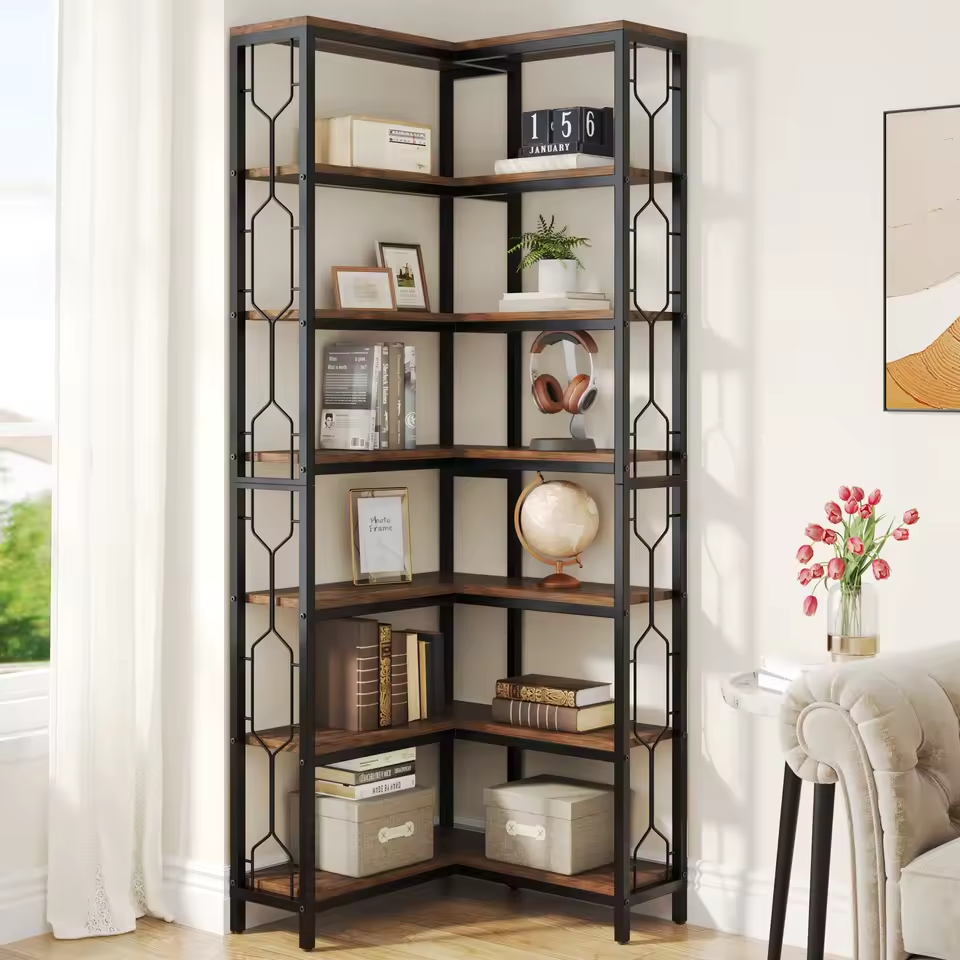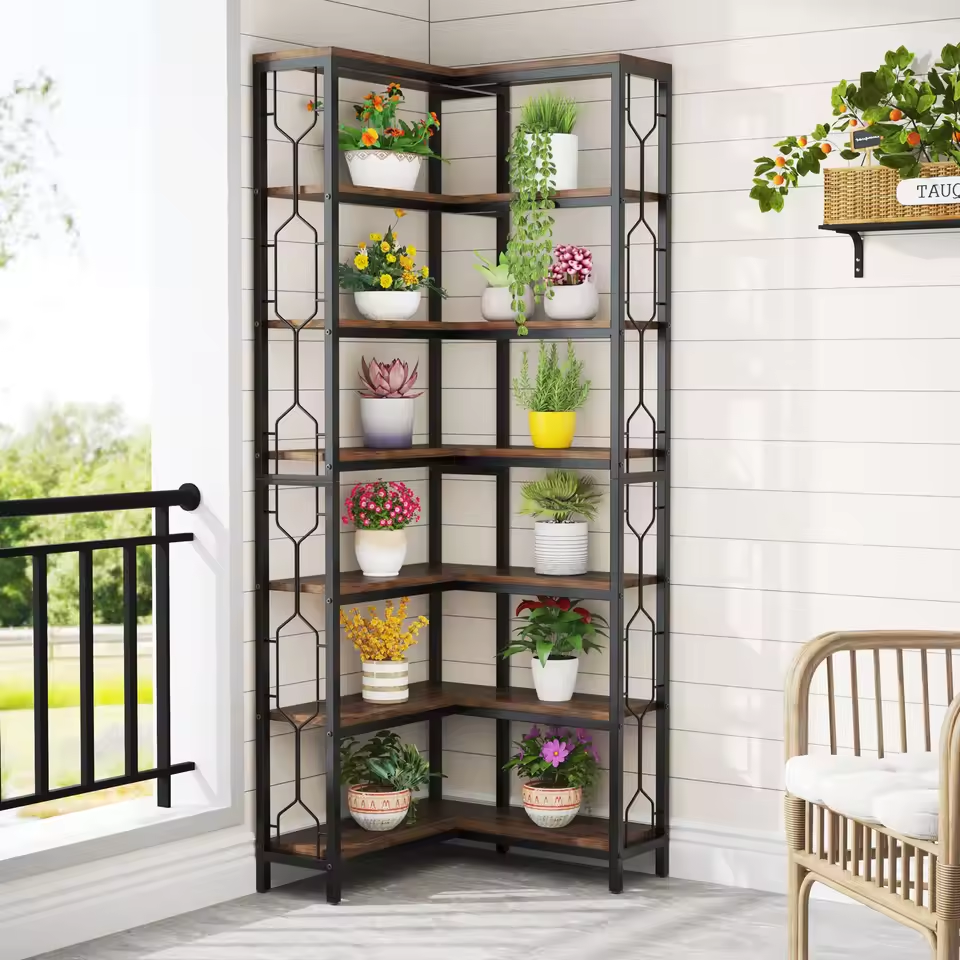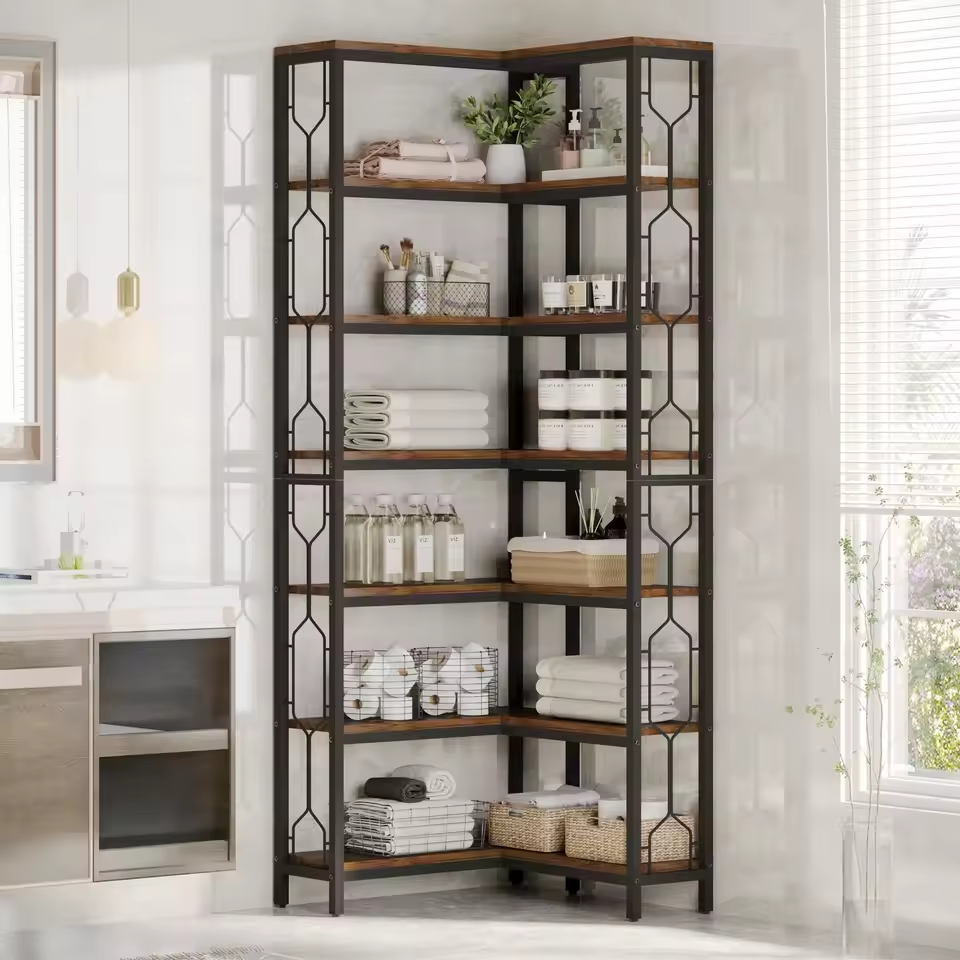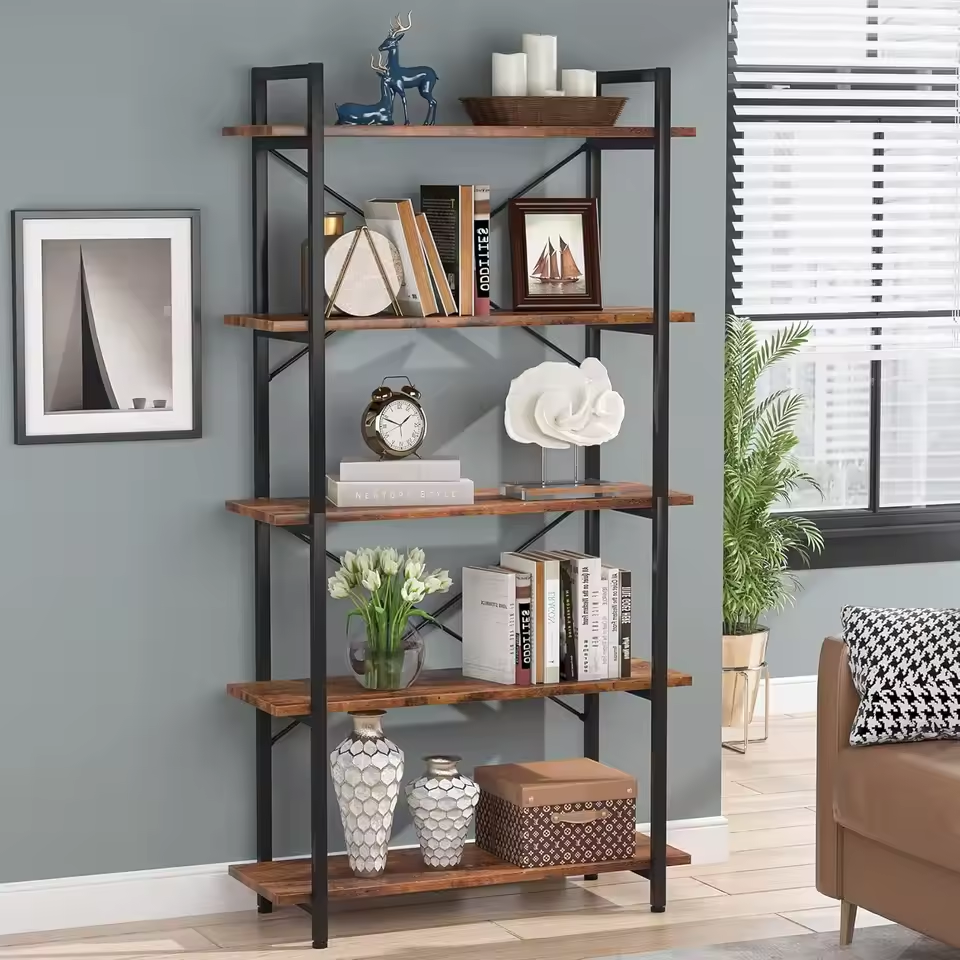What Defines a Rustic Bookshelf?
When it comes to blending functionality with aesthetic warmth, few pieces of furniture stand out quite like a rustic bookshelf. This type of shelving unit is more than just a place to store books—it’s a statement of character, a nod to craftsmanship, and an anchor for cozy interior design. A rustic bookshelf typically features raw wood finishes, visible grain patterns, and subtle imperfections that celebrate its handmade or reclaimed origins. Unlike sleek, factory-produced shelves, a rustic bookshelf embraces knots, cracks, and weathering as part of its charm. These characteristics give it a lived-in feel, making it ideal for homes that aim for a warm, inviting atmosphere.

Whether crafted from pine, oak, or barn wood, the material selection plays a crucial role in defining the shelf’s overall look and durability. Many rustic bookshelves also incorporate iron or blackened steel brackets, adding a touch of industrial contrast that enhances their visual depth. What truly sets a rustic bookshelf apart is its authenticity. In an age where mass-produced furniture dominates the market, choosing a piece that feels personal and timeless is a deliberate design choice. It reflects a desire for sustainability, as many rustic bookshelves are made from reclaimed or repurposed wood, reducing environmental impact.
Additionally, their construction often emphasizes sturdiness over disposability, meaning they’re built to last for generations. From cabin-style homes to urban lofts with farmhouse flair, the rustic bookshelf fits seamlessly into a variety of spaces. It’s not just about holding books—it’s about creating a focal point that tells a story. Whether you inherit one from a family member or commission a local artisan, a rustic bookshelf carries emotional weight. It becomes a vessel for memories, displaying not only literature but also cherished trinkets, photos, and travel souvenirs. In this way, it transcends mere utility and becomes an integral part of your home’s narrative.
The Timeless Appeal of Natural Materials
The enduring charm of a rustic bookshelf comes from its use of natural, unprocessed materials that bring warmth and authenticity to any room. Crafted primarily from solid wood—such as reclaimed barn wood, pine, or oak—these shelves showcase unique grain patterns, knots, and subtle imperfections that highlight their handmade quality.
Unlike mass-produced furniture with synthetic finishes, a rustic bookshelf celebrates the raw beauty of nature. Each piece tells a story through its texture and color variations, making it one-of-a-kind. The wood is often left with a matte or lightly waxed finish to preserve its organic feel, enhancing both visual and tactile appeal.
Complementary materials like wrought iron brackets or aged metal hardware add structural strength while boosting the vintage aesthetic. These natural elements age gracefully, developing a rich patina over time instead of deteriorating.
Moreover, using sustainable materials aligns with eco-conscious living. Many rustic bookshelves are made from repurposed wood, reducing waste and environmental impact. This connection to nature fosters a calming, grounded atmosphere in the home.
Ultimately, the natural materials in a rustic bookshelf offer more than just durability—they create a sense of timelessness and authenticity that elevates your space beyond mere functionality.

Where to Place Your Rustic Bookshelf
A rustic bookshelf is more than just storage—it’s a statement piece that adds warmth and character to any room. Choosing the right location enhances both its function and visual impact.
In the living room, position it beside a sofa or armchair to create a cozy reading corner. It can also serve as a media console, holding books, decor, and electronics while softening the look of modern entertainment units.
Bedrooms benefit from a rustic bookshelf near the bed or in a quiet corner. It’s perfect for storing bedtime reads, journals, and personal mementos, adding a comforting, lived-in feel.
Home offices gain instant charm when a rustic bookshelf organizes books, binders, and supplies. Its natural texture balances sleek desks and digital devices, creating a more inviting workspace.
Don’t overlook entryways or mudrooms. A sturdy rustic bookshelf can hold shoes, hats, and bags while welcoming guests with its handmade appeal.
Kitchens and dining areas also make great spots—display cookbooks, ceramic dishes, or wine glasses for a farmhouse touch.
Even children’s rooms can feature a rustic bookshelf, offering durable, attractive storage for toys and storybooks.
When placing your shelf, consider lighting, traffic flow, and balance. Natural light enhances the wood’s grain, while proper spacing ensures accessibility.
Ultimately, a rustic bookshelf works best where it can be seen and appreciated—bringing timeless charm to everyday spaces.

Styling Tips for Maximum Visual Impact
Styling a rustic bookshelf goes beyond stacking books—it’s an opportunity to curate a visual narrative. To achieve balance, begin by mixing vertical and horizontal book placements. Stacking some books horizontally breaks monotony and creates space for small decor items like candles or framed photos. Grouping books by color or size, rather than subject, often produces a more cohesive and designer look. Incorporate varying heights of objects—tall vases, medium-sized plants, and small trinkets—to add dimension. Greenery, such as potted succulents or trailing ivy, brings life and softness to the rugged wood. Consider these three key principles:
- Balance and Symmetry: Place heavier items at the bottom and lighter ones toward the top. Use symmetrical arrangements on either side of a central object (like a large sculpture) for a polished look.
- Personal Touches: Display family photos, handmade pottery, or souvenirs from travels. These items make the shelf uniquely yours and spark conversation.
- Negative Space: Don’t overcrowd. Leave some shelves partially empty to let the eye rest and highlight individual pieces.
Use baskets or fabric bins on lower shelves to store clutter while maintaining aesthetic harmony. Rotate seasonal decor—pumpkins in fall, pinecones in winter—to keep the shelf feeling fresh. With thoughtful styling, your rustic bookshelf becomes more than storage—it becomes art.
DIY Rustic Bookshelf: Build Your Own Charm
Building your own DIY rustic bookshelf is a rewarding project that combines creativity, craftsmanship, and personal expression. With basic tools and reclaimed or salvaged wood—like old pallets, barn boards, or fencing—you can create a one-of-a-kind piece that reflects your style and values.
Start by designing a simple frame: ladder-style with slanted sides or a classic upright rectangle. Cut shelves to size, sand lightly to smooth sharp edges while preserving natural wear, and assemble using wood screws or dowels for a sturdy build. Reinforce joints with iron brackets for an authentic, industrial-rustic touch.
Choose a finish that enhances the wood’s character—try a weathered gray stain, dark walnut, or clear sealant to protect while keeping it natural. For added charm, incorporate details like chalkboard labels, carved initials, or hidden cubbies.
This hands-on approach not only saves money but deepens your connection to the piece. Every knot and mark tells a story, making your rustic bookshelf more than furniture—it’s a keepsake. Whether you’re a beginner or experienced builder, a DIY rustic bookshelf brings unmatched satisfaction and timeless appeal to your home.

Rustic vs. Modern: Finding the Right Balance
Creating a harmonious space with a rustic bookshelf in a modern setting is all about thoughtful contrast and balance. Here are key tips to blend the two styles seamlessly:
- Use the rustic bookshelf as a focal point: Place it against a neutral or minimalist wall to let its natural texture and grain stand out. This contrast draws the eye and adds warmth to an otherwise sleek space.
- Pair with clean-lined furniture: Complement the organic feel of the shelf with modern pieces—like a low-profile sofa, glass coffee table, or metal-legged side tables. This mix keeps the room balanced and uncluttered.
- Incorporate industrial lighting: Choose fixtures with chrome, steel, or matte black finishes to bridge rustic charm and contemporary style. Pendant lights or track lighting work well above or near the shelf.
- Maintain a cohesive color palette: Stick to neutral tones—whites, grays, and beiges—for walls and larger furniture. This allows the wood’s natural hues to shine while keeping the space feeling open and modern.
- Add subtle modern accents: Decorate the rustic bookshelf with minimalist vases, geometric bookends, or monochrome artwork. These small touches unify the two aesthetics without overpowering the shelf’s character.
- Balance textures: Offset the roughness of wood with smooth surfaces like leather cushions, polished stone, or soft rugs. This layering creates depth and comfort.
By thoughtfully combining elements, a rustic bookshelf doesn’t clash with modern decor—it enhances it, bringing soul and history into a contemporary home.
Caring for Your Rustic Bookshelf

To keep your rustic bookshelf looking beautiful and structurally sound for years, follow these essential care tips:
- Dust regularly with a soft cloth: Use a dry or slightly damp microfiber cloth weekly to remove dust and prevent it from settling into the wood grain. Always dry the surface immediately to avoid moisture damage.
- Avoid harsh chemicals: Steer clear of ammonia-based or abrasive cleaners that can strip natural oils and damage the finish. Opt for gentle, natural solutions like a mix of vinegar and olive oil or beeswax polish.
- Condition the wood periodically: Apply a natural wood conditioner or furniture wax every 3–6 months to nourish the wood and maintain its luster, especially in dry climates.
- Keep it away from extreme conditions: Place your rustic bookshelf away from direct sunlight, radiators, air conditioners, and humid areas like bathrooms to prevent warping, fading, or cracking.
- Prevent water damage: Never place wet items directly on the shelves or clean with soaking-wet cloths. Use coasters or mats under vases and plants to protect the wood.
- Handle scratches and dents gently: For minor scratches, use a wood touch-up pen or wax filler. Deeper damage may require light sanding and reapplication of finish.
- Rotate and redistribute weight: Shift displayed items occasionally to ensure even wear and avoid sagging shelves. Avoid overloading beyond the recommended weight.
With proper maintenance, your rustic bookshelf will age gracefully, developing a warm patina that enhances its charm and character over time.
Why a Rustic Bookshelf Is a Lasting Investment
A rustic bookshelf is more than just a place to store books—it’s a long-term investment in quality, style, and sustainability. Crafted from solid, often reclaimed wood, it’s built to withstand daily use and last for decades, unlike mass-produced furniture that wears out quickly. Its timeless design transcends trends, seamlessly fitting into evolving decor styles—from farmhouse to modern loft.
Beyond durability, a rustic bookshelf carries emotional value. Whether handmade, inherited, or passed down, it becomes a vessel for memories, displaying cherished books, photos, and mementos. Its natural imperfections tell a story, adding soul to your space.
Moreover, many rustic bookshelves are made from eco-friendly, repurposed materials, supporting sustainable living. With proper care, it ages gracefully, developing a rich patina that enhances its beauty over time.
Unlike a rotating bookshelf designed for novelty, a rustic bookshelf stands the test of time—offering both function and character. In a world of fast furniture, choosing a piece that lasts is not just practical, but meaningful.